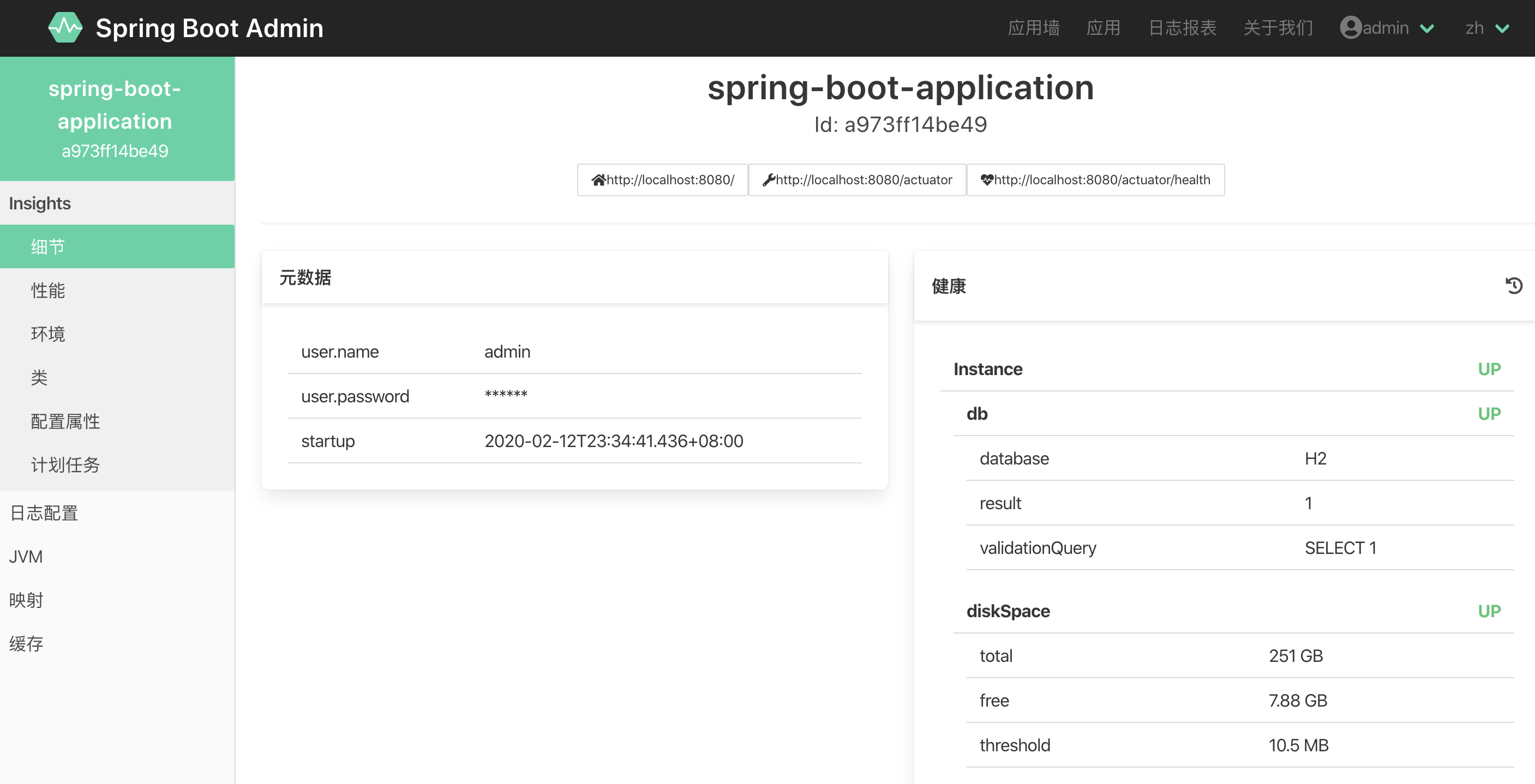Spring Boot Admin的使用
前面的文章我们讲了Spring Boot的Actuator。但是Spring Boot Actuator只是提供了一个个的接口,需要我们自行集成到监控程序中。今天我们将会讲解一个优秀的监控工具Spring Boot Admin。 它采用图形化的界面,让我们的Spring Boot管理更加简单。
先上图给大家看一下Spring Boot Admin的界面:

从界面上面我们可以看到Spring Boot Admin提供了众多强大的监控功能。那么开始我们的学习吧。
配置Admin Server
既然是管理程序,肯定有一个server,配置server很简单,我们添加这个依赖即可:
<dependency>
<groupId>de.codecentric</groupId>
<artifactId>spring-boot-admin-starter-server</artifactId>
<version>2.2.2</version>
</dependency>
同时我们需要在main程序中添加@EnableAdminServer来启动admin server。
@EnableAdminServer
@SpringBootApplication
public class SpringBootAdminServerApplication {
public static void main(String[] args) {
SpringApplication.run(SpringBootAdminServerApplication.class, args);
}
}
配置admin client
有了server,我们接下来配置需要监控的client应用程序,在本文中,我们自己监控自己,添加client依赖如下:
<dependency>
<groupId>de.codecentric</groupId>
<artifactId>spring-boot-admin-starter-client</artifactId>
<version>2.2.2</version>
</dependency>
我们需要为client指定要注册到的admin server:
spring.boot.admin.client.url=http://localhost:8080
因为Spring Boot Admin依赖于 Spring Boot Actuator, 从Spring Boot2 之后,我们需要主动开启暴露的主键,如下:
management.endpoints.web.exposure.include=*
management.endpoint.health.show-details=always
配置安全主键
通常来说,我们需要一个登陆界面,以防止未经授权的人访问。spring boot admin提供了一个UI供我们使用,同时我们添加Spring Security依赖:
<dependency>
<groupId>de.codecentric</groupId>
<artifactId>spring-boot-admin-server-ui-login</artifactId>
<version>1.5.7</version>
</dependency>
<dependency>
<groupId>org.springframework.boot</groupId>
<artifactId>spring-boot-starter-security</artifactId>
</dependency>
添加了Spring Security,我们需要自定义一些配置:
@Configuration
public class WebSecurityConfig extends WebSecurityConfigurerAdapter {
private final AdminServerProperties adminServer;
public WebSecurityConfig(AdminServerProperties adminServer) {
this.adminServer = adminServer;
}
@Override
protected void configure(HttpSecurity http) throws Exception {
SavedRequestAwareAuthenticationSuccessHandler successHandler =
new SavedRequestAwareAuthenticationSuccessHandler();
successHandler.setTargetUrlParameter("redirectTo");
successHandler.setDefaultTargetUrl(this.adminServer.getContextPath() + "/");
http
.authorizeRequests()
.antMatchers(this.adminServer.getContextPath() + "/assets/**").permitAll()
.antMatchers(this.adminServer.getContextPath() + "/login").permitAll()
.anyRequest().authenticated()
.and()
.formLogin()
.loginPage(this.adminServer.getContextPath() + "/login")
.successHandler(successHandler)
.and()
.logout()
.logoutUrl(this.adminServer.getContextPath() + "/logout")
.and()
.httpBasic()
.and()
.csrf()
.csrfTokenRepository(CookieCsrfTokenRepository.withHttpOnlyFalse())
.ignoringRequestMatchers(
new AntPathRequestMatcher(this.adminServer.getContextPath() +
"/instances", HttpMethod.POST.toString()),
new AntPathRequestMatcher(this.adminServer.getContextPath() +
"/instances/*", HttpMethod.DELETE.toString()),
new AntPathRequestMatcher(this.adminServer.getContextPath() + "/actuator/**"))
.and()
.rememberMe()
.key(UUID.randomUUID().toString())
.tokenValiditySeconds(1209600);
}
}
接下来,我们在配置文件中指定服务器的用户名和密码:
spring.boot.admin.client.username=admin
spring.boot.admin.client.password=admin
作为一个客户端,连接服务器的时候,我们也需要提供相应的认证信息如下:
spring.boot.admin.client.instance.metadata.user.name=admin
spring.boot.admin.client.instance.metadata.user.password=admin
spring.boot.admin.client.username=admin
spring.boot.admin.client.password=admin
好了,登录页面和权限认证也完成了。
Hazelcast集群
Spring Boot Admin 支持Hazelcast的集群,我们先添加依赖如下:
<dependency>
<groupId>com.hazelcast</groupId>
<artifactId>hazelcast</artifactId>
<version>3.12.2</version>
</dependency>
然后添加Hazelcast的配置:
@Configuration
public class HazelcastConfig {
@Bean
public Config hazelcast() {
MapConfig eventStoreMap = new MapConfig("spring-boot-admin-event-store")
.setInMemoryFormat(InMemoryFormat.OBJECT)
.setBackupCount(1)
.setEvictionPolicy(EvictionPolicy.NONE)
.setMergePolicyConfig(new MergePolicyConfig(PutIfAbsentMapMergePolicy.class.getName(), 100));
MapConfig sentNotificationsMap = new MapConfig("spring-boot-admin-application-store")
.setInMemoryFormat(InMemoryFormat.OBJECT)
.setBackupCount(1)
.setEvictionPolicy(EvictionPolicy.LRU)
.setMergePolicyConfig(new MergePolicyConfig(PutIfAbsentMapMergePolicy.class.getName(), 100));
Config config = new Config();
config.addMapConfig(eventStoreMap);
config.addMapConfig(sentNotificationsMap);
config.setProperty("hazelcast.jmx", "true");
config.getNetworkConfig()
.getJoin()
.getMulticastConfig()
.setEnabled(false);
TcpIpConfig tcpIpConfig = config.getNetworkConfig()
.getJoin()
.getTcpIpConfig();
tcpIpConfig.setEnabled(true);
tcpIpConfig.setMembers(Collections.singletonList("127.0.0.1"));
return config;
}
}
本文的例子可以参考github.com/ddean2009/l…
更多教程请参考 flydean的博客